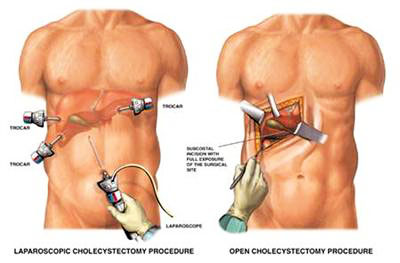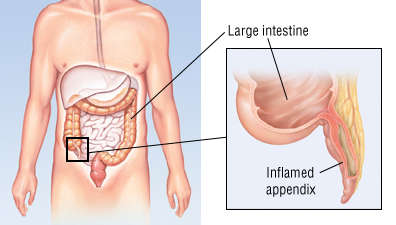Gallbladder surgery, also known as cholecystectomy, is a common surgical procedure performed to remove the gallbladder. The gallbladder is a small organ located beneath the liver, and its primary function is to store bile, a digestive fluid produced by the liver. Gallbladder surgery is typically recommended when gallstones or other issues cause pain, inflammation, or complications.

There are two main types of gallbladder surgery:
1.Laparoscopic Cholecystectomy: This is the most common and minimally invasive approach. The surgeon makes several small incisions in the abdomen and inserts a laparoscope (a thin, lighted tube with a camera) and special instruments to remove the gallbladder. Patients often experience a quicker recovery time and less pain compared to open surgery.
2.Open Cholecystectomy: In some cases, an open surgery may be necessary, especially if there are complications or if laparoscopic surgery is not feasible. This involves a larger incision in the abdomen, providing the surgeon with direct access to the gallbladder. Open cholecystectomy may require a longer recovery period.
3.After gallbladder surgery, some individuals may experience changes in their digestion, as the gallbladder is no longer present to store and release bile in response to meals. However, the body can adapt to the absence of the gallbladder, and most people can resume a normal diet.
Common reasons for gallbladder surgery include:
1.Gallstones: Hardened deposits that form in the gallbladder and can cause pain and inflammation.
2.Gallbladder Inflammation (Cholecystitis): Inflammation of the gallbladder, often due to gallstones blocking the flow of bile.
3.Gallbladder Polyps: Small growths on the inner lining of the gallbladder that may require removal.
4.Biliary Dyskinesia: A condition where the gallbladder doesn't function properly, leading to pain and digestive issues.
Gallbladder surgery is generally considered safe, and complications are rare. However, as with any surgery, there are potential risks, and it's essential to discuss the benefits and risks with your healthcare provider. Recovery time varies but is typically relatively quick, with many people returning to normal activities within a week or two after laparoscopic surgery.
Appendicitis
Appendicitis is a condition in which your appendix gets inflamed. The appendix is a small pouch attached to the end of the large intestine.

Causes
Appendicitis is a very common reason for emergency surgery. The problem most often occurs when the appendix becomes blocked by feces, a foreign object, a tumor or a parasite in rare cases.
Symptoms
The symptoms of appendicitis can vary. It can be hard to detect appendicitis in young children, older people, and women of childbearing age.
The first symptom is often pain around the belly button or mid upper abdomen. Pain may be minor at first, but becomes more sharp and severe. You may also have a loss of appetite, nausea, vomiting, and a low-grade fever.
The pain tends to move into the right lower part of your belly. The pain tends to focus at a spot directly above the appendix called McBurney point. This most often occurs 12 to 24 hours after the illness starts.
Your pain may be worse when you walk, cough, or make sudden movements. Later symptoms include:
- Chills and shaking
- Hard stools
- Diarrhea
- Fever
- Nausea and vomiting
You may never have given much thought to your appendix, the little pouch that's attached to the top of your large intestine. And you wouldn't have much reason to think about it, because it doesn't seem to do anything. But if your appendix were to become swollen and inflamed, it would probably move to the front of your mind. The pain of appendicitis can make you quickly, and unpleasantly, familiar with this organ. You can get appendicitis if your appendix becomes blocked. That blockage could be from feces, a foreign object, or, in rare cases, a tumor. When your appendix is blocked up, bacteria that normally live inside it start multiplying like crazy, and cause an infection. If you've got appendicitis you'll usually have pain that's centered around the area of your belly button. At first the pain may be minor, but it can get very severe and will usually drift downward to the bottom right part of your abdomen. You may also have nausea, vomiting, diarrhea or constipation, and a low fever. Your pain may let up for a time. This relief can be misleading, though. Just when you think you're getting better, your appendix may have actually burst. If that's the case, the pain will get start to get more and more intense. To diagnose appendicitis, your doctor will ask about your symptoms and press on your abdomen, which will feel very tender. You may need imaging tests, such as a CT scan or ultrasound of your abdomen, so the doctor can see if the problem is with your appendix. If you have appendicitis, the number one way to treat it is with surgery to remove your appendix. In fact, appendicitis is the number one cause of emergency abdominal surgery in the U.S. You may be treated for an infection first, before your surgery. It's important to treat the appendicitis quickly because you can develop a collection of pus called an abscess in your abdomen once your appendix bursts. Don't worry about going through life without an appendix. People live healthy lives without it. Once you've had your appendix taken out, you should feel a lot better. If your appendix has ruptured, it may take you longer to recover. You may also develop an abscess or other complications. That's why you don't want to wait until your appendix has already burst to get treated. Call your doctor for any severe pain in your abdomen, especially if you also have a fever, vomiting, constipation, dizziness, or other severe symptoms.
Treatment
Most of the time, a surgeon will remove your appendix as soon as you are diagnosed.
If a CT scan shows that you have an abscess, you may be treated with antibiotics first. You will have your appendix removed after the infection and swelling have gone away.
The tests used to diagnose appendicitis are not perfect. As a result, the operation may show that your appendix is normal. In that case, the surgeon will remove your appendix and explore the rest of your abdomen for other causes of your pain.
Appendectomy, the removal of the small pouch attached to the beginning of your large intestine when you have an acute bout of appendicitis is one of the most common emergency abdominal surgeries. The appendix is a small, finger-shaped organ that comes out of the first part of the large intestine. It needs to be removed when it becomes swollen or infected. If the appendix is not removed, it can leak bacteria and infect your entire belly, which can be very life threatening. So, what are the signs that you have appendicitis? Well, this condition can be fairly hard to diagnose, especially in children, older people, and women of childbearing age. Usually, the first symptom is pain around your belly button. The pain might be mild at first, but then it gets sharp and severe before not too long. The pain may then move into your right lower abdomen. You may also have diarrhea, fever, nausea, and a reduced appetite. Sometimes, people think that they might be having food poisoning. Your doctor will make a diagnosis based on your symptoms. You may also have blood tests and a CT scan or ultrasound. Once it's clear that you have appendicitis, your doctor will probably schedule you for emergency surgery. In surgery, you will receive anesthesia and be asleep and pain free. The doctor will make a small cut in the lower right side of your belly and remove your appendix. If the surgeon uses the laparoscopic technique, you will have several small cuts in your abdomen for the surgical instruments. If your appendix broke open, or a pocket of infection has formed, your doctor will wash out your belly during the surgery. A small tube may remain to help drain out fluids or pus. Once you've had an appendectomy, you will probably recover pretty quickly. It feels good to get a bad appendix out. Most patients leave the hospital 1 to 2 days after surgery. The good news is that you'll be able to go back to all those normal activities within 2 to 4 weeks.
